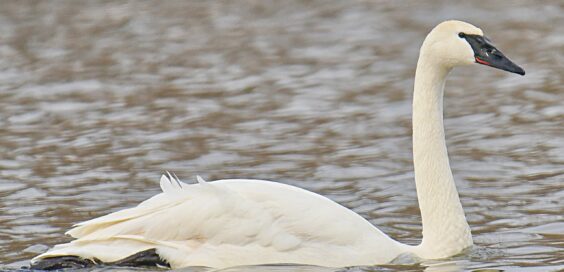
Creature Feature – Trumpeter Swans Staging a Comeback
Posted by Dustin Horton // February 6, 2023 // Articles, Creature Feature
After indiscriminate hunting nearly erased them from the landscape over 200 years ago, trumpeter swans are now reclaiming much of their former range thanks to successful restoration efforts. While still uncommon in New York, trumpeters are being reported, including a flock at Montezuma National Wildlife Refuge this past November.
Adult trumpeters have snowy-white plumage and long, elegant necks. Tipping the scales at nearly 25 pounds with an 8-foot wingspan, these big beauties need a 325-foot runway for take-off. To gain speed, they lumber along, pounding the water with their powerful wings and feet.
Trumpeters require clean, spacious bodies of water, where aquatic plants make up most of their diet. They breed on isolated wetlands in Canada, Alaska and the northwestern U.S. and spend the winter on coastal inland bodies of water that remain free of ice. Winter can be a great time to observe trumpeters, as they begin gathering in larger flocks. In spring and summer, mated pairs that often share a lifelong bond are busy hatching and raising cygnets in more secluded areas. In fall, they teach their youngsters to fly.
Due to their habitat and feeding behaviors, trumpeter swans are highly susceptible to lead poisoning through the accidental ingestion of lead ammunition and lead fishing tackle. In fact, lead poisoning is a leading cause of trumpeter swan mortality. Please help protect swans and other at-risk wildlife by sporting lead free.
Have you seen trumpeter swans? If so, visit the Trumpeter Swan Society online at trumpeterswansociety.org to report your sighting. Many trumpeters have leg bands and yellow wing tags with a 3-digit code. If possible, relay the code, number of swans observed, and location. The website also has helpful trumpeter swan ID tips.
Article by Margie Manthey
Photo by Simon J. Vandervoort













